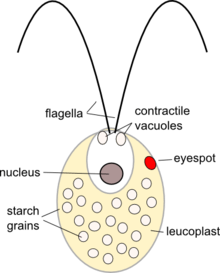Polytoma
Polytoma is a genus of green algae in the family Chlamydomonadaceae. Polytoma is a genus of colorless, free-living chlorophytes similar in form to Chlamydomonas but lacking chlorophyll. Two flagella emanate from the anterior papilla of the cell, and cells have two contractile vacuoles at the flagellar base. Polytoma possesses a leukoplast in place of a chloroplast, in which many starch grains are concentrated; there is no pyrenoid. Since they lack photosynthetic capability, Polytoma species are entirely saprotrophic, obtaining nutrients from decaying organic matter. Some species possess an eyespot apparatus (stigma) in the anterior portion of the leucoplast, but in others this organelle is absent.[2]
- This article describes a green algae. For the orchid, see Bletilla.
| Polytoma | |
|---|---|
 | |
| Scientific classification | |
| Phylum: | Chlorophyta |
| Class: | Chlorophyceae |
| Order: | Chlamydomonadales |
| Family: | Chlamydomonadaceae |
| Genus: | Polytoma Ehrenberg |
| Species[1] | |
| |
References
- See the NCBI webpage on Polytoma. Data extracted from the "NCBI taxonomy resources". National Center for Biotechnology Information. Retrieved 2007-03-19.
- Smith, G. M. (1950) The Freshwater Algae of the United States, 2nd ed. New York: McGraw Hill, pp.78-79
External links
This article is issued from Wikipedia. The text is licensed under Creative Commons - Attribution - Sharealike. Additional terms may apply for the media files.